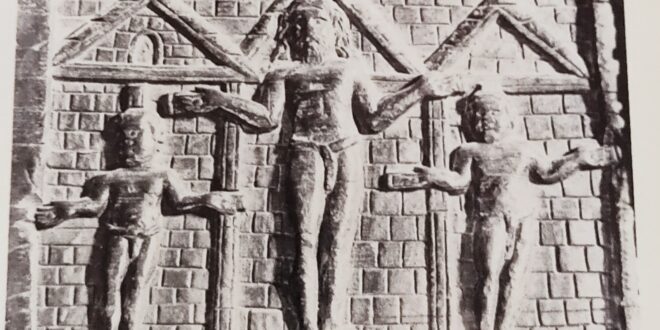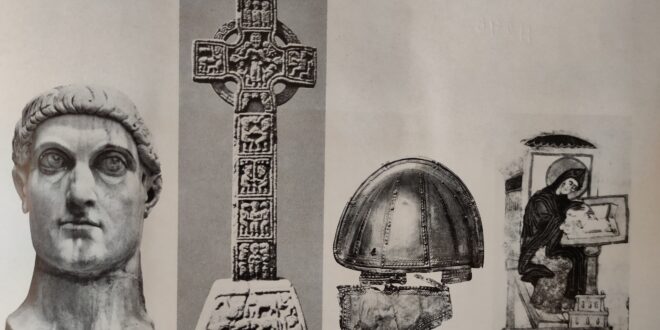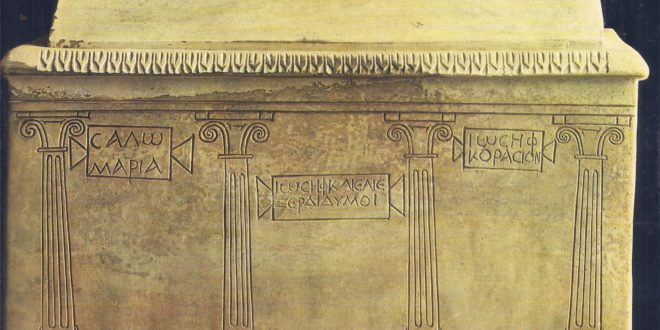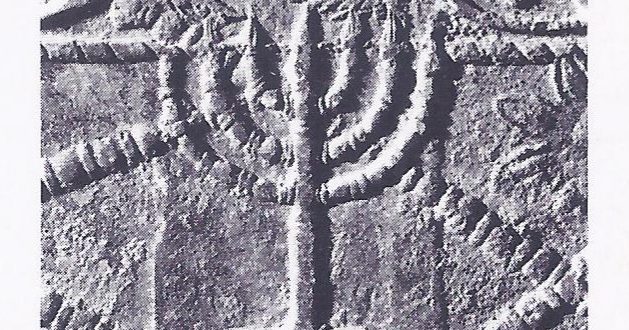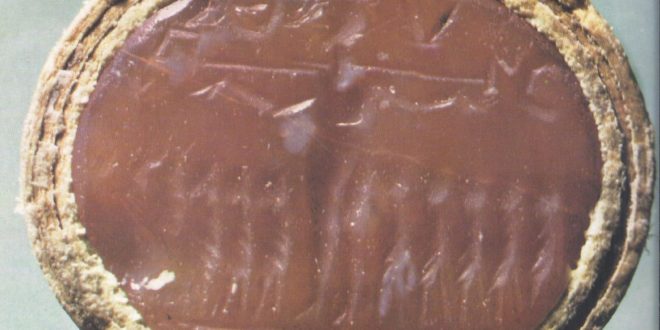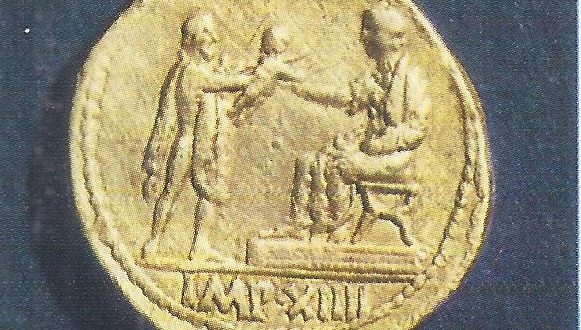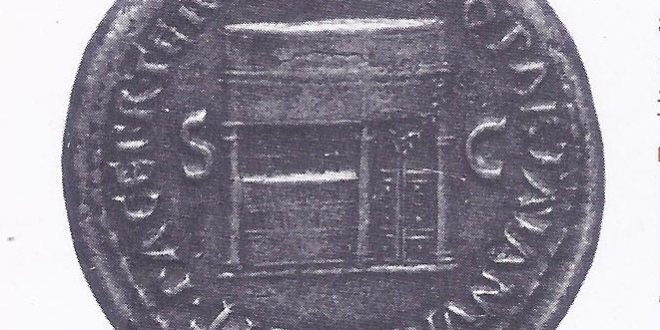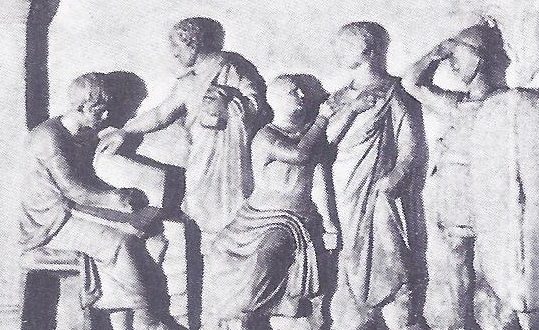The Arian threat occured in the fourth century, which opened with the triumph of Christianity in the Roman Empire, closed with the beginning of the Dark Ages. Leaders of the barbarian tribes, massing outside the Empire’s frontiers, had already infiltrated their agents into the high places of imperial politics. The old order of Roman imperial administration, already severely weakened in the late third century and only partly restored by the reforms of Diocletian, was gradually disrupted during the years following Constantine’s death. Thus, the gulf between the East, where the imperial system continued and the West, where conditions of virtual anarchy came to prevail, can be clearly seen. The breakup of the West into a number of smaller units was already in prospect. The main subject of this passage will be events in Europe and the Eastern Roman Empire, but at the same time, things were happening outside Europe in some cases parallel to European history, in others, dramatically different from it. The World of the Orient In the Far East, the once-great empire of Han China had fallen apart in the early third century and China was long, to remain in a state of political turmoil. Then came the establishment of the Tsin dynasty in the year 265 and about this time, a new force was beginning to make itself felt in northern China. During the fourth and fifth centuries, meanwhile, the Tsin were to extend their power into the southeast and a new era, in Chinese social and cultural history, was inaugurated. Taoist stele; northern Wei period At first the Tsin power in the north had been severely curtailed by the incursion from beyond the frontiers of Hunnic tribes from central Asia. A number of warring barbarian dynasties were established in the north, but they were supplanted in …
Read More »In This Sign Shalt Thou Conquer (312 A.D.)
Constantine’s victory at the Milvian Bridge, ensures the spread of Christianity, throughout the Roman Empire. The Roman Empire, at the end of the third century A.D., was at the point of collapse. Struggles amongst rival emperors brought frequent civil wars, while barbarian hordes threatened the borders. Early in the new century, a soldier named Constantine proclaimed himself Emperor and immediately set out to make good his claim in a series of campaigns that took him, by the summer of 312, to the edge of Rome. Constantine had a momentous vision — a vision in which he was told, that he would conquer in the sign of the Cross, the symbol of the despised young Christian religion. The warrior’s subsequent victory at the Battle of the Milvian Bridge won for Christianity, an end to persecution and recognition as a legal religion. The third century of the Christian era was a grim, squalid age. For centuries the Roman Empire had maintained peace and fostered prosperity throughout the Mediterranean world, but now it was in decline. Stable central power had collapsed, as a succession of would-be warlords marched their predatory armies up and down the Empire, striving to seize power or to hold it against their rivals. Sometimes the legions actually put the Empire up for auction. At one and the same time, there might be three or four self-styled emperors. None of them lasted long. An allegorical figure on the pediment beneath the colossal head of Constantine in Rome, representing one of the provinces of the Empire. Meanwhile, the lot of the common man became ever more miserable and uncertain as cities were sacked, the countryside ravaged and wealth confiscated to pay the rapacious soldiery. Debasement of the currency and interruption of trade routes led to galloping inflation. The urbane, sophisticated culture …
Read More »A. D.
A. D. is not meant to imply a time when fires were burning continually from 312 A.D. to 1204 A.D. Yet fires there were: fires lit by zealous men that consumed the ancient gods, ancient cultures and eventually men themselves. The rise of Christianity, to its position as the official Church of Constantine’s Empire, was accompanied by fires, in which the temples and other treasures of ancient cultures were destroyed — for example, the library at Alexandria. Then the Islamic fires from the desert seemed to consume the gardens of late antiquity, where vases and statues had survived from the age of Hellenism. At the dawn of our own age, in 1204 A.D., the crusaders plundered and set fire to Constantinople and destroyed, for the time being at least, the Empire of the Romans. The Byzantine Empire and in particular Constantinople itself, with its glittering palaces, its baths, its art treasures and its luxury, was coveted as much by the tenth-century Ottonian Germans as by the Franks — the Latin Christians of 1204 A.D. The fires of faith, the bright lights of destruction, the explosions of fanaticism, the everlasting wars and feuds that filled this era — was there ever a year when there reigned a peace comparable to the pax romana that Augustus had envisaged, or the pax mongolica, that the great Mongolian khans created, at the height of their power ? All the undoubted devastation should not make us forget that the fires of faith brought life as well as destruction. The contents of this post demonstrate that the dynamic forces that created the western world had their origin in these troubled centuries, and that the foundations of European culture up to the present day were laid over a thousand years ago. We know both a great deal …
Read More »Zealots and the Destruction of Zion(70 A.D.)
Zealots, for sixty years or more, had formed the “resistance’’ against the Romans in Judaea and their ideas were shared by many other Jews who were not active members of their party. After the death of King Agrippa in A.D. 44, Judaea returned to direct Roman rule and from that moment Jewish history seemed to take on an air of inevitability. According to orthodox Jewish belief the Holy Land belonged to God and God alone. The presence of a Roman Governor in Jerusalem was in itself an affront to God and to pay tribute to the Emperor was to give to a non-believer what was God’s by right. Tension and disorder steadily increased, stimulated by Roman maladministration, Messianic excitement and nationalist activity. The fatal explosion finally came in A.D. 66. With the resulting loss of their land and the Temple at Jerusalem, the Jews’ religion ceased to be a religion that demanded the ritual of sacrifice and the people themselves were scattered abroad without a national home until the present century. In the summer of the year 66 the priests of the great Temple of Yahweh in Jerusalem refused to offer their customary daily sacrifices for the well-being of the Roman Emperor and people. These sacrifices were an accepted token of Israel’s loyalty to Rome and a refusal to continue making them was tantamount to a declaration of revolt. The priests concerned were members of the lower order of the Temple clergy, who subscribed to Zealotism. General view of Jerusalem Behind this refusal of the lower priests lay a complex situation. The higher clergy, who formed a priestly aristocracy, were presided over by the High Priest. This aristocracy supported the Roman government of Judaea because it ensured their own social and economic position; the maintenance of the “loyal” sacrifices was …
Read More »Revolt and Destruction of Judea (30 – 70 A. D.)
Judea was destroyed and it’s people were scattered due to revolt in the East. Herod the Great died in the spring of 4 B.C.; his death sparked off an explosion of the long pent-up feelings of his Jewish subjects. Revolts immediately broke out in different parts of the country under various leaders. The situation was made worse by a Roman procurator, Sabinus, who moved in with troops to secure Herod’s very considerable property for the Emperor Augustus. At Jerusalem, crowded with pilgrims for the feast of the Passover, armed conflict soon broke out. The Romans were ordered to withdraw by the rebels, “and not to stand in the way of men who after a lapse of time were on the road to recovering their national independence.” This statement of Jewish aims, which is recorded by the Jewish historian Josephus, is significant. It embodied an ideal, inspired by traditions of the heroic days of David and the Maccabees, which was rooted in the peculiar nature of Jewish religion. Every Jew was brought up to believe and the belief was reinforced daily by the study and practice of the Torah — that Yahweh, the god of Israel, had given his people the land of Canaan as their Holy Land, where they were faithfully to serve him. This belief implied a conception of the state as a theocracy; Yahweh owned it and was its sovereign lord, and his vice-regent on earth was the high priest. This conception in turn implied the freedom of the Jewish people to devote themselves to the maintenance of this theocracy. Judaea under Roman rule The Jewish revolt, which was apparently uncoordinated, was eventually suppressed by Varus, the Roman governor of Syria, who intervened with two legions and ruthlessly crushed the rebels, two thousand of whom he crucified. What …
Read More »Jesus of Nazareth, Saviour God of a New Religion (30 A.D.)
Jesus of Nazareth, his life and death, for Romans alive about A.D. 30 was of no significance whatsoever. In the context of Roman history, Jesus was just another rebellious troublemaker. After the revolt of Spartacus thousands of slaves had been crucified in the same way as Jesus. His death was merely one more item in the list of repressions that Rome found necessary to carry out in order to consolidate her power. Yet in the end, the religion founded by Jesus would take over the Roman Empire itself and eventually make its way all over the world. The consequences for the subsequent history of civilization were incalculable. Writing early in the second century, the Roman historian Tacitus told his readers how Nero had been suspected of burning Rome in A.D. 64. To free himself from suspicion, the infamous Emperor “fastened the guilt and inflicted the most exquisite tortures on a class hated for their vices, whom the people called Christians. Christus, from whom the name derived, suffered the extreme penalty during the reign of Tiberius on the order of the procurator Pontius Pilate. The pernicious superstition, suppressed for the moment, broke out again, not only in Judaea, the source of the evil, but in Rome itself… . Accordingly, acknowledged members of the sect were first arrested; then, upon their evidence, an immense multitude was convicted, not so much of the crime of firing the city, as of hatred of mankind.” This significant passage from the Annales of Tacitus shows what an educated Roman knew and thought about Christianity some eighty years after its birth. To him it was a dangerous subversive movement whose founder had been executed for sedition by the Roman governor of Judaea; but that had only temporarily checked the movement and it had spread from Judaea to …
Read More »Arminius, Liberator of Germany (9 A.D.)
By 9 B.C. it seemed that Augustus’ ambition to extend Roman territory to the Elbe had almost been achieved, but the Romans overestimated the extent to which they had successfully assimilated their new province. Encouraged by revolts in the Empire, German aspirations to freedom and prowess in arms both found their champion in Arminius, a German by birth, but also a Roman citizen. Arminius’ knowledge of the terrain made a German victory a strong possibility and his annihilation of the legions sent to maintain order shook the Empire to its core. Rome was forced to abandon any idea of a province beyond the Rhine and the implications for the future of Europe were incalculable. Augustus pushed the frontiers of Roman dominion outward in almost every direction, but during the forty-five years of his sole rule he was forced to fight constant and simultaneous campaigns to maintain the lines he wished to draw on the map of Europe. The frontier between the subject province of Gaul and barbarian Germany was to prove especially troublesome and the whole might of Rome eventually was to be challenged by one barbarian leader, Arminius, of the Cherusci tribe. Arminius, whom Tacitus called the liberator of Germany, was not the first German to threaten Rome. Around the end of the second century B.C., two barbarian tribes, the Cimbri and the Teutons, had gradually migrated southward from the neighbourhood of Jutland until they reached the northern frontier of Rome. After pushing the Roman armies as far south as Orange, in the Gallo-Roman province of Narbonensis, they proceeded toward Italy itself. They were stopped, however, by one of Rome’s outstanding generals, Marius, who defeated them at Aix-en-Provence in 102 B.C. and obliterated them at Vercelli the following year. Germanic pugnacity engraved itself upon the Roman mind and tongue: …
Read More »Octavian and the New Roman Empire (B.C. 31 – 9 A.D.)
Octavian delivers the state from that was plunged into depression. A few weeks after January 1 in the year 29 B.C. the doors of the temple of Janus in Rome were closed. This traditional act symbolized that the Roman state was at peace. The closing of the doors on this occasion was greeted with more than the usual joy and relief that marked the termination of war. Since the murder of Julius Caesar in the Forum in the year 44 B.C., Rome had been plunged, with little intermission, in civil war. From that long agony, the state had finally been delivered by Octavian’s victory at Actium and the subsequent deaths of Antony and Cleopatra. The Senate and people of Rome were, in consequence, deeply grateful to the man who had brought them this relief, and they were disposed to accept his leadership. Augustus Octavian Supreme Octavian knew this and recognized the strength of his present position, but he was also astute and cautious, as well as being a statesman profoundly concerned with the future well-being of Rome. He perceived what were the realities of power and what were its trappings; and he was careful never to confuse the two. Augustus with the goddess Roma His uncle, Julius Caesar, of a more flamboyant nature than his own, in the moment of his power had offended Republican principles and had fallen beneath the knives of ardent Republicans. The civil war had taken a heavy toll of these Roman oligarchs; but even in the year 29 Rome was still officially and by a long and revered tradition, a republic. It would be imprudent to disregard the fact. Weaknesses of Republican Structure The civil war and the struggle between Pompey and Caesar that had preceded it, had revealed the weakness of the Republican constitution. It could …
Read More »The Emperor Augustus (B.C. 31)
The assassination of Julius Caesar in 44 B.C. initiated thirteen years of bloodshed, during which the people who had plotted his death were hunted down and those who remained in positions of power disputed that power among themselves. Finally, the struggle resolved itself into a duel between Octavian, Caesar’s grand-nephew heir and Marc Antony, his most able lieutenant, in alliance with Cleopatra, Queen of Egypt. In the final confrontation at the naval battle of Actium, Marc Antony and Cleopatra were routed and Octavian became ruler of the world as the Emperor Augustus. Egypt’s last bid for world empire had been thwarted. More importantly, the work begun by Julius Caesar was continued and the transition from the anarchy of the end of the Roman Republic to the glory of Empire was completed. Late in the summer of 31 B.C., the two largest fleets the world had ever seen confronted each other off the northwestern shores of Greece. The four or five hundred warships of Marc Antony, including sixty belonging to Queen Cleopatra of Egypt, faced outward into the Ionian Sea. Against this navy stood another of approximately equal size, which had come with the young Octavian, the future Emperor Augustus, from Italy. War had been declared against the foreigner Cleopatra and by implication, against Antony, her husband in Egyptian, though not in Roman law. The crews on each side numbered well over a hundred thousand men. Apollo of Actium; a Roman coin issued by Augustus, for whose victory in the battle the god Apollo was held to have been responsible. Behind Antony’s ships, on the opposite banks of the narrow channel leading into the Gulf of Ambracia, were posted the two rival armies, each more than eighty thousand strong. Octavian’s troops had come from Italy and landed at a port in …
Read More »The Roman Republic is Reborn with Imperial Splendour (73 – 31 B.C.)
The happy judgment of the historian Polybius on the strength of the Roman constitution, because of its mixture of popular, oligarchic and monarchical elements, might certainly appear as an optimistic theorization after the revolt of Spartacus. The Roman state had been shaken by a bitter and violent social disturbance that had only been resolved by two individuals whose power, though technically constitutional, was far too great for the Senate to feel comfortable. Crassus, the multimillionaire and Pompey, the popular general — had succeeded where the regularly appointed consuls had failed and the “extraordinary commands” with which they had been vested were a de iure recognition of the fact that the Roman state was now on the brink of being run by powerful individuals. The existence of such extraordinary commands, continuing until Octavian resolved the power struggle by his Victory at Actium and set about establishing the Roman Empire, with one individual in permanent possession of autocratic powers, indicates that the needs of the Roman state could no longer be met by using the established constitutional procedure. In the earlier days of the Republic, generals had been given special authority in the face of a serious military threat, but the Senate had carefully limited their authority and had been strong enough to keep control. If we look back at the period of Rome’s expansion into the Mediterranean, we shall see that the Senate had in fact, grown in strength, but that its increasing influence in government, also brought with it the potential for individuals to influence affairs. Sacrificial procession of the Roman Republic The Roman Senate During the Roman republic’s period of wars and expansions, from the time of the Punic wars onwards, the Senate, composed as it was of men whose experience and status gave them the ability to judge …
Read More »